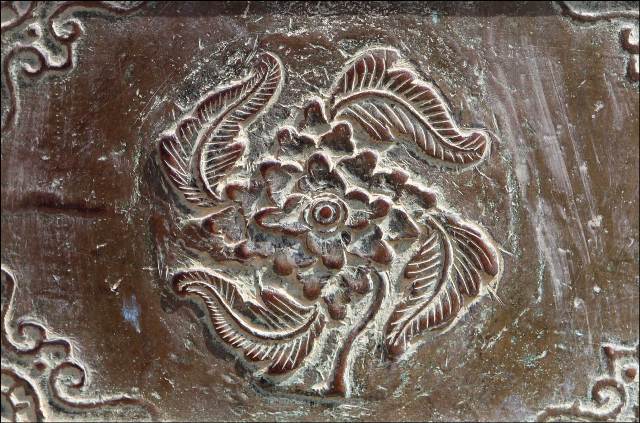
The imaginary circle of a decorative pattern on a bronze cauldron in King Nguyen Phuc Tan's times (1648 - 1687)
Considered as the springboard for the development of decorative art on bronze artifacts of the Nguyen Dynasty, the bronze artifacts in the Nguyen lords' times have their own characteristics. They reflect the cultural context and the aesthetic tendency of Dang Trong (the Cochinchina). However it is those artifacts that have not been adequately studied.
The popular decorative style of that time is panels in a strip. This can be seen through such artifacts as the Great Bell at Thien Mu Pagoda and the 11 bronze cauldrons of the Nguyen Lords' times, which are now being preserved at various relics around Hue City. A noteworthy feature is that the decorative details on the panels are usually round in shape or of circular pattern.
In the Eastern conception, the circle often represents gathering, fullness and the immutability of space and time since it has neither beginning nor end. In Buddhism, it is expressed through the wheel of samsara, symbolizing the movement of nature. In Zen Buddhism, concentric circles represent stages of inner perfection and spiritual self-development. The circle, for Islam, is considered the most complete. To Indians in North America, the circle is representation of time, etc. Thus in both the East and the West, the circle is of important significance not only in conception but also in decoration and architecture.
Circular decorative patterns on bronze artifacts of the Nguyen Lords' times are more or less associated with the concepts of belief and aesthetics, creating a distinct style of the period. Through surveying and analyzing the artifacts, with the aid of graphic software, we found out an interesting and noteworthy point: the decorative patterns are all located within an imaginary circle; they move around a center, creating movement.
In visual arts, this feature creates visual motion that makes decorative details look moving. Is this accidental or intentional? To answer this question, we need to examine the characteristics of the visual arts, the historical and cultural context and the characteristics of craftsmen of that period. In addition, it is necessary to take cultural exchanges and acculturation into consideration as well because those factors affect the visual art style of each stage in history.
Is this circular decorative style related to the historical context of the then Cochinchina when Buddhism was regarded as the national religion by the Nguyen lords? Besides, the circular and spiral motifs can also be found on Dong Son bronze artifacts. The question is whether or not the relation between them.
Regardless of any factor that governs, it is undeniable that the decorative circular patterns on bronze artifacts of the Lord Nguyen's times have their own design, creating a typical style of that time and contributing to traditional cultural and artistic values of the country.
Story and photo: Phan Le Chung